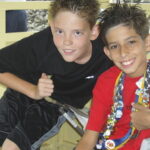I hope my computer does not die from the oak dust drifting slowly through the air and filtering into the vital parts like the motherboard and hard drive, pronouncing sure death for this useful but ornery machine that I have to use if I’m going to tell you about the wooden pendants I make for necklaces, pins and other jewelry items.
I purchase ¼” x 4″ oak boards at the local home improvement center. They come in either two or four foot lengths. I have already painstakingly created my pattern (usually in Word) printed it out on my one technologically more-fancy-than-I-need device, a laser printer, cut out a plastic pattern from a coffee can lid or a piece of plastic purchased from the hobby shop, and trace the outline onto the board.
Never being one noted for his great penmanship, I never cease to surprise myself when I take the length of wood to the band saw, and accomplish a fairly exact wooden replica of a longhorn, butterfly, or cross. I use a band saw, but you might choose a scroll saw if you are easier on blades than I am! If there are inside cuts like there are on the butterfly pendants I make, the scroll saw is perfect.
Partially for something to do, and partly just to prove to myself I can do it, I carve those inside spots out; it makes me feel like the master carvers who long ago created the beautiful horses one finds on the carousel at the amusement park.
When a piece is cut out, the fun really begins. I gather my various grits of sandpaper so I can do what they call “going through the grits,” that’s not eating breakfast its sanding down the ages and faces of your pendants in multiple steps. I usually start with a 60 grit and finally finish off with a 320.
When you cut out designs like my longhorns and butterflies, there are some rather intricate and small places to sand that you can’t really get at effectively with sandpaper. For those places some other small tools come in handy. I purchased a set of needle files for about $5.00 and a set of rifflers (small jeweler’s rasps) for about 20 bucks. These have both improved the quality of my finished product, and saved wear and tear on the side of my index finger that I used to have to protect through the sanding process with a piece of tape wrapped around it.
There are many reasons I chose oak for the material out of which to make my pendants. It is durable; one of the only common woods I can cut thin enough to both look good and not break when I cut out the horns on my longhorn pendants. But the most important reason I chose it is for its beauty and ease of staining. I use a one-step product that both stains and polyurethanes in one step. If you follow the directions on the can, you stain it let it dry, go over it with steel wool, and apply a second coat. Unless you just want it darker though, I find one coat works pretty well.
After the pieces dry or sometimes before I stain them, I drill a small hole in the top with a rotary tool and small bit to help start screwing a small eye hook in place through which I thread a piece of leather. After the leather is in place I complete the necklace with barrel clasps, and have a product that looks good around one’s neck or, like we do here in Texas, hanging from the rearview mirror of the pickup truck.
This process is one that I do not only for profit, there’s a more important reason for it. When I am concentrating on making these pendants, the problems in the world and the ones specific to my own little corner of it just seem to disappear. Hey, you know what? Even if you do turn it into a for-profit endeavor, there’s nothing like a hobby to smooth out the rough spots in life–just like sanding eliminates those on the edges of a Texas cut-out.




